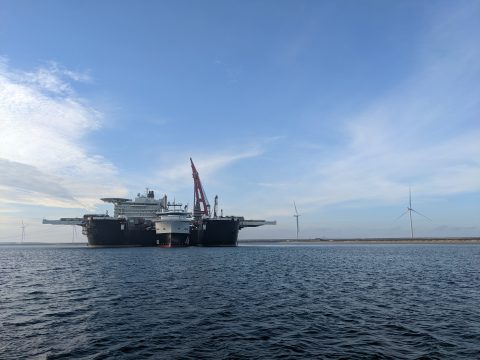
Inside Allseas’ Pioneering Spirit (video)
Installing and removing jackets and topsides from offshore platforms, laying pipelines, and housing over 500 crew members… Allseas’ impressive Pioneering Spirit does it all. The world’s largest working vessel is now moored at the Prinses Alexiahaven, in Rotterdam for the winter. It will also be receiving some upgrades.
It takes over fifteen minutes to sail from the Futureland mooring jetty in Maasvlakte 2, to the Pioneering Spirit. On the way, one can spot the APM Terminal Maasvlakte’s ship-to-shore cranes, the Sif Group yard and its bright yellow monopiles, as well as the Tweede Maasvlakte wind turbines in action.
The giant recently completed a project near Denmark, installing the jacket and topside for the DolWin6 wind farm. Now she is in Rotterdam to spend the winter, until early 2023, says PR manager Jeroen Hagelstein. During this period, the crew will complete any necessary repairs. A frame is also being added to the anchor, and the topside lift system’s capacity is being upgraded from 48,000 tonnes to 60,000 tonnes, for a specific upcoming project.
The topside and jacket lift systems are truly the Allseas trump card. The Pioneering Spirit is unique in its ability to lift entire platform topsides in a single piece. The vessel manoeuvres around the platform with its dual-bow structure, like a horseshoe. It can then remove structures, using 170-metre-long lifting beams, at the vessel’s stern. Single lift installation and removal reduce the amount of offshore work required, which is safer and more cost-effective.
World’s largest construction vessel
Assisting with the top lift capacity upgrade, nestled in the ‘slot’ between the vessel’s twin hulls, is the offshore construction vessel, the Oceanic. Built in 2016, this vessel sails under the Maltese flag. With an overall length of 129 metres and a beam of 25 metres, this vessel has a gross tonnage of 12,397 tonnes, while the slot itself measures 122 metres in length and 59 metres in width.
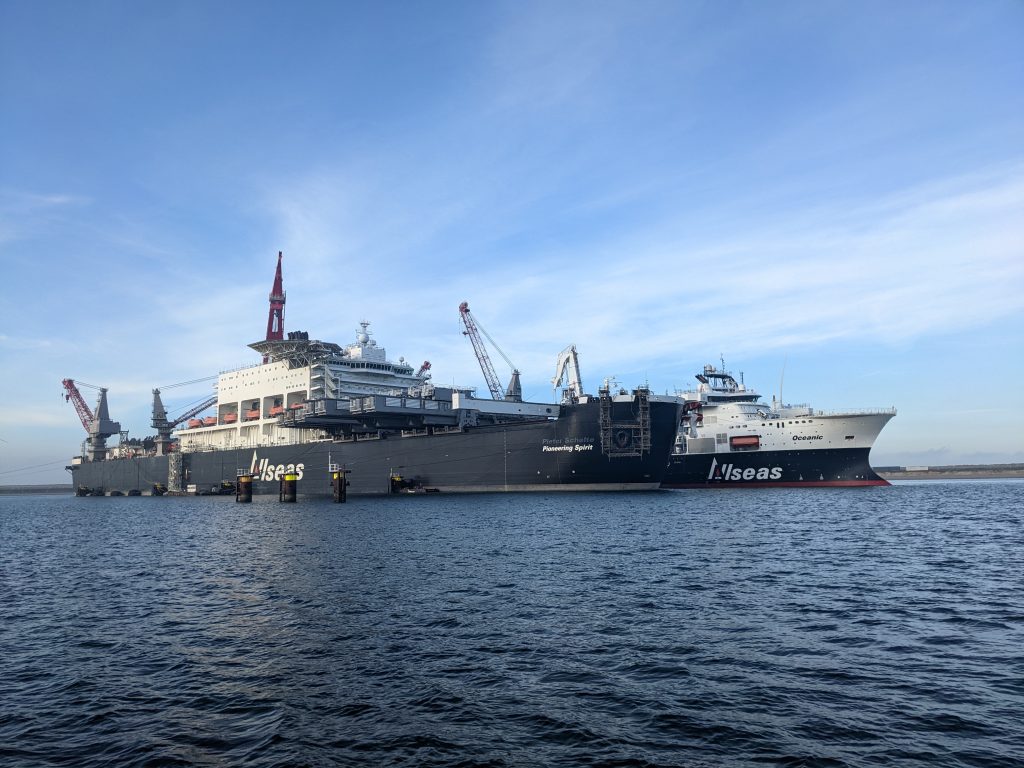
These dimensions pale in comparison to the Pioneering Spirit, whose overall length, including tilting lift beams and stinger, reaches 477 metres. Excluding the beams and stinger, the ship measures 382 metres, making it the third largest vessel in the world, after the Seawise Giant and the Emma Maersk.
But it is not just these dimensions that lead Allseas’ ship to be referred to as the largest working vessel in the world. “That is the water displacement, by which the size of ships is more often measured in rankings,” said Hagelstein. “This ship has a water displacement of one million tonnes. And also the lifting capacity makes her the largest.”
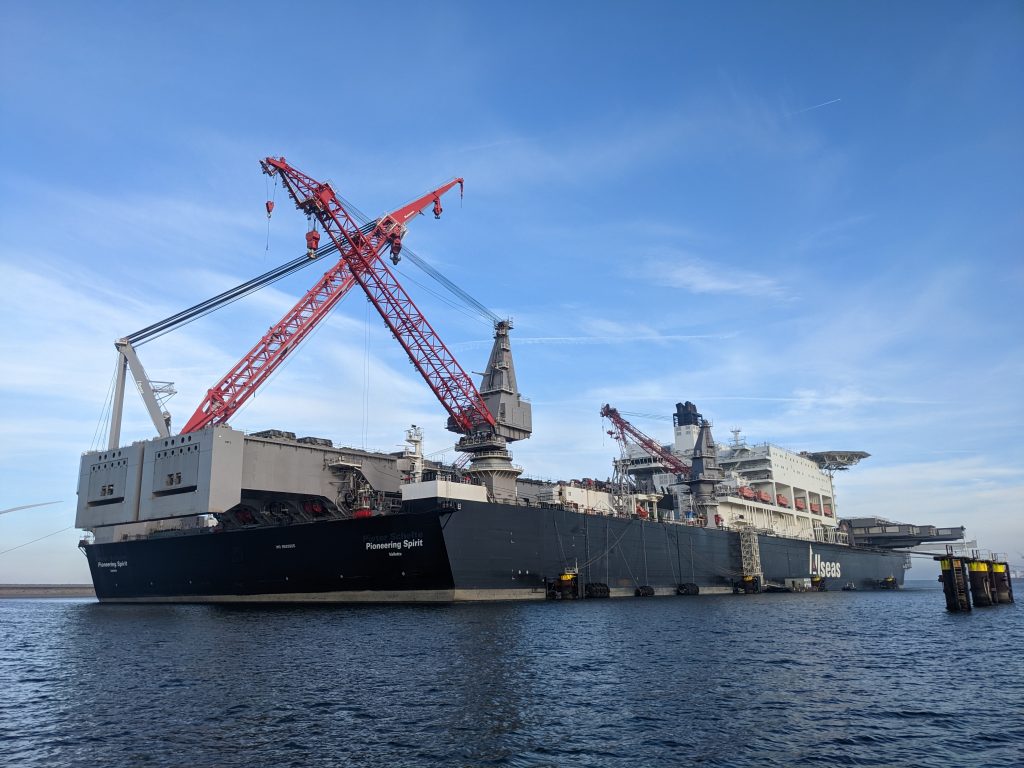
A Floating factory
The Pioneering Spirit is also a pipe-laying vessel, the world’s largest in fact. It is therefore endowed with several special features that facilitate this task. It has three 50-tonne pipe transfer cranes, for the loading pipes measuring 12 metres in length, with diameters ranging from two to 68 inches (5,06 to 172.72 centimetres). The ship can carry up to 27,00 tonnes of pipe cargo at once.
Once loaded onto the ship, the 12-metre sections of pipe are welded together in the onboard production line, before being gradually laid on the seabed. This is done in the vessel’s double-joint ‘factory’, with five line-up stations and two stations for combined external and internal welding. The vessel also has a firing line with 6 double joints, welding stations, and 6 coating stations.
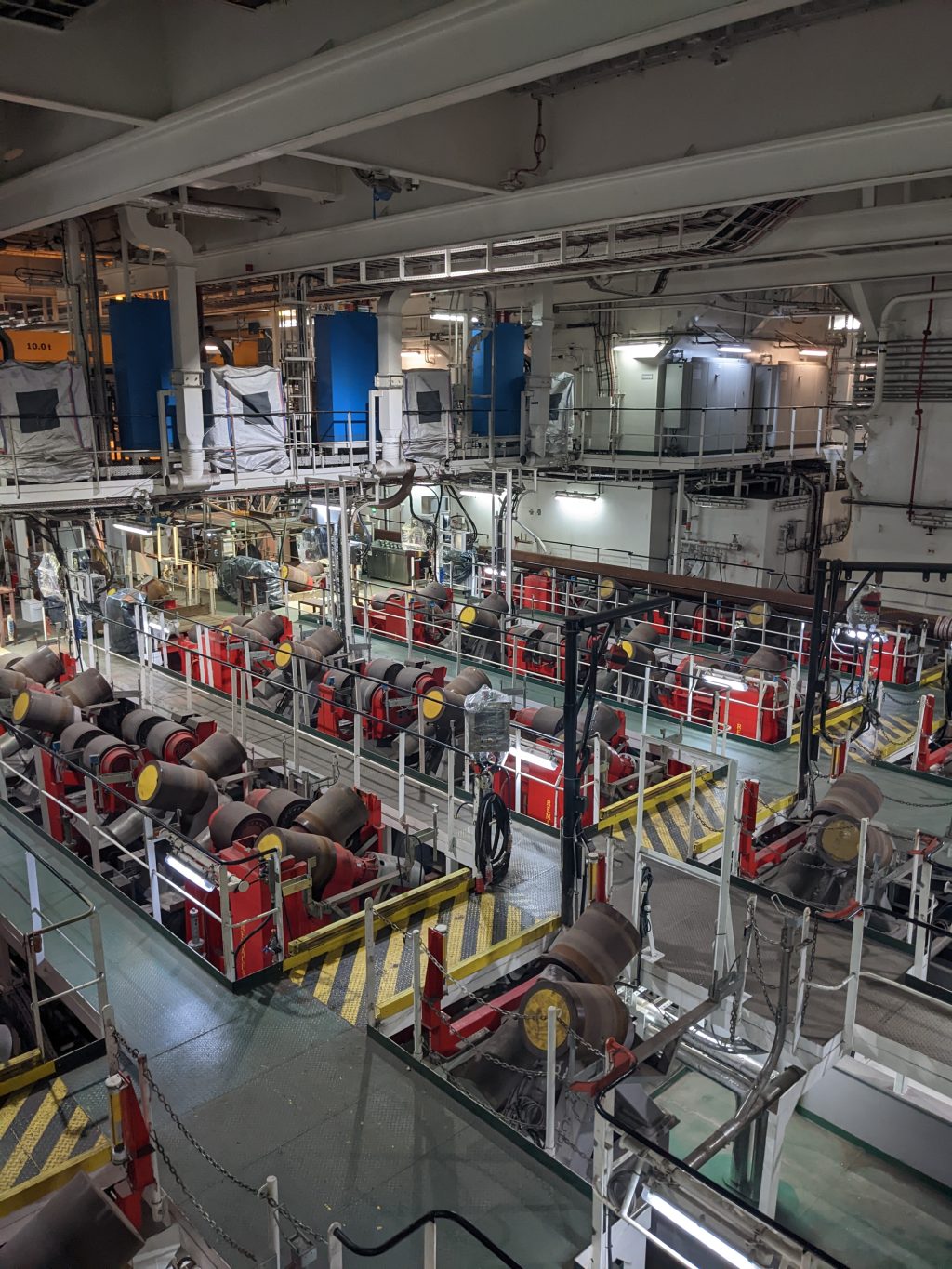
The Pioneering Spirit worked on several major pipe-laying projects including the construction of the 2,500-kilometre Nord Stream 2 gas pipeline in 2019. “From the beginning, we knew there were US sanctions hanging over our heads,’ Hagelstein said. ‘And when we still had 130 kilometres of pipeline to lay, those sanctions kicked in and we had to stop. But the customer paid us for all the kilometres laid.”
A vessel with a heart
The Pioneering Spirit’s two hulls create a U-shaped inlet at the front. Captain Fred Regtop shared an anecdote, about how the ship got her unique shape. Apparently, during the vessel’s construction at the South Korean DSME shipyard, owner Edward Heerema noticed that there was space left on both sides. “So the ship can be wider! Just cut it in half and put another piece in between,” Heerema said, according to this story.
And so the vessel was expanded. In the production line of the pipe welding factory, the literal ‘heart’ of the ship is on the intermediate welded piece: it is a metal work of art, painted red and black. One can also notice the likeness of this metallic heart sculpture, emblazoned on Captain Regtop’s hard hat.
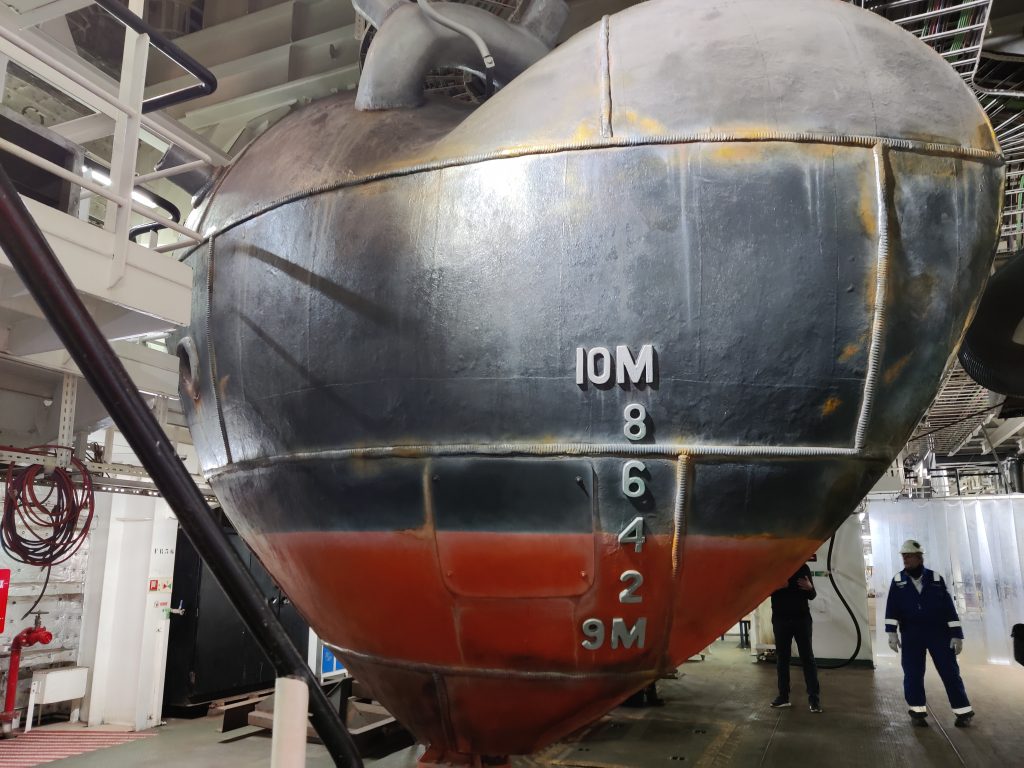
Crew accommodations
And if the vessel can be said to have a heart, the blood pumping through its veins is then the crew. Up to 571 individuals can live on board the Pioneering Spirit at the same time. Made up of over 20 different nationalities, the crew is divided into different teams. The marine crew handles the sailing of the ship, the construction crew is involved in the offshore and pipe laying work, and the engineering crew handles the vessel’s functioning and upkeep.
To support the crew, which lives on the vessel in five-week rotations, working 12-hour shifts, the catering crew handles the food, laundry and cleaning of the vessel, while the medical crew run the vessel hospital. In addition to the cantine, the crew members can enjoy a karaoke room, and a bar (which serves two alcoholic drinks per person only on Saturday nights in port). The vessel can store food provisions for up to 9 months, but fresh food is delivered every week or two by other support ships. The vessel also has a gym, which is often so full that sign-up sheets are necessary, despite the fact that the average Pioneering Spirit crew member walks upwards of 20 kilometres a day.
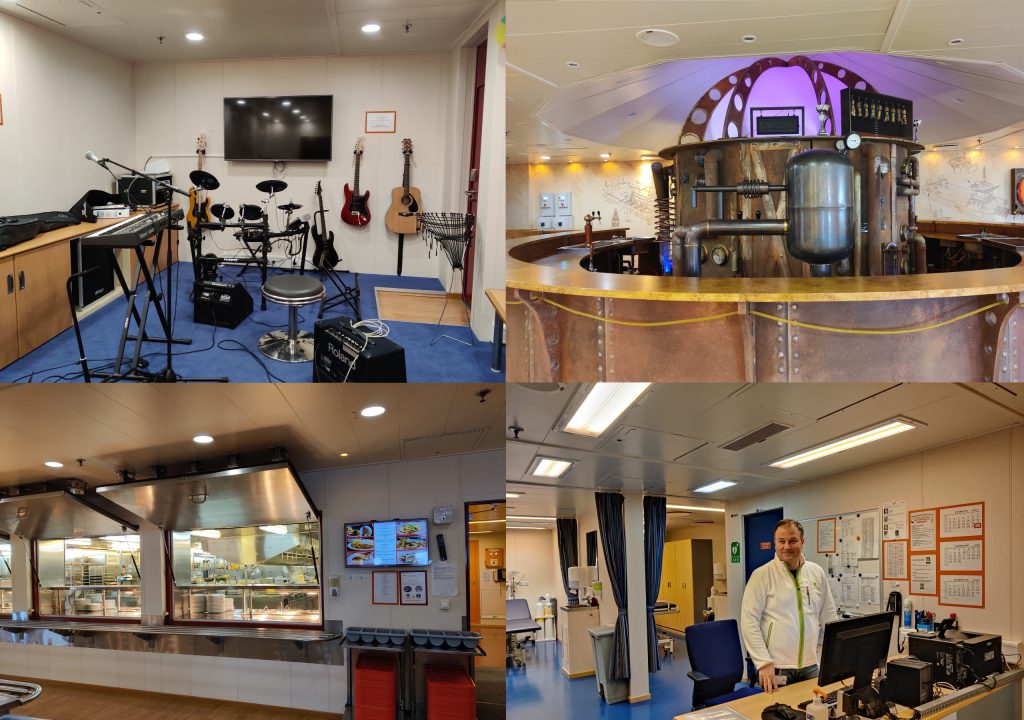
Always On
At the moment, only about 300 crew members are on board the vessel. “The ship is actually always “on”. Even when it is not working on projects,” says Hagelstein. “This is because it takes much more energy to switch the ship off and only start it up again when projects are underway.” The Pioneering Spirit is not connected to shore power because the Alexiahaven is a temporary mooring that does not have a connection. To supply power, one or more of the nine diesel engines on board are always running. The ship would only be powered down for a cold lay-up lasting several years, and this is unlikely to happen.
From 2023, Allseas will have to work hard to keep up with demand from the gas and oil sector. “Due to the high oil price and high energy demand, oil companies are investing a lot in new developments. Even the smaller companies now want to work hard on their infrastructure.” The vessel’s design and huge lifting capacity allow it to operate relatively quickly, with less preparatory work.
That is important in these busy times, says Captain Fred Regtop. “I have to postpone my retirement a bit because of the busy times and the general staff shortage,” he laughs. Regtop sees staff shortages all over the maritime sector. “But we are still lucky that this work looks so powerful, which makes people want to come here. And the ship is so stable, you don’t even realise you are working at sea.” So stable, in fact, that it is one of two Allseas vessels boasting an aquarium.
https://vimeo.com/769049002/01b220e5b8
You just read one of our premium articles free of charge
Want full access? Take advantage of our exclusive offer





